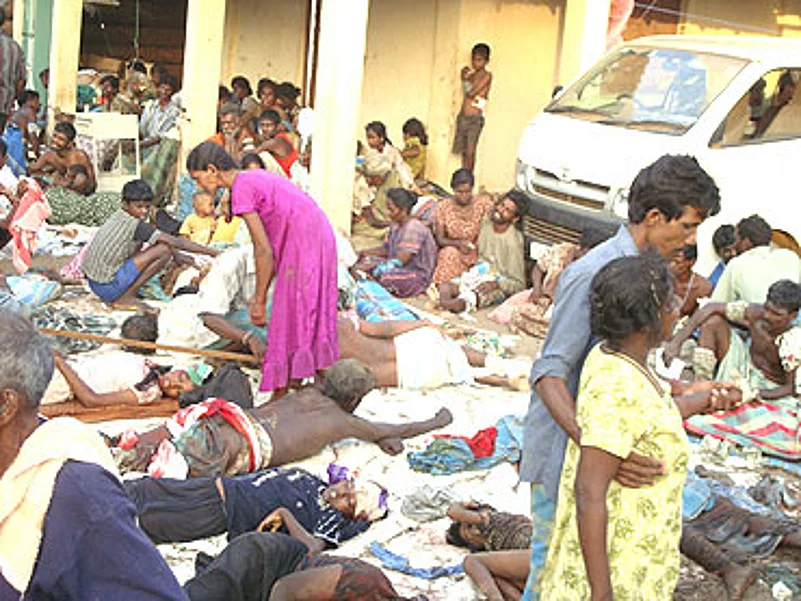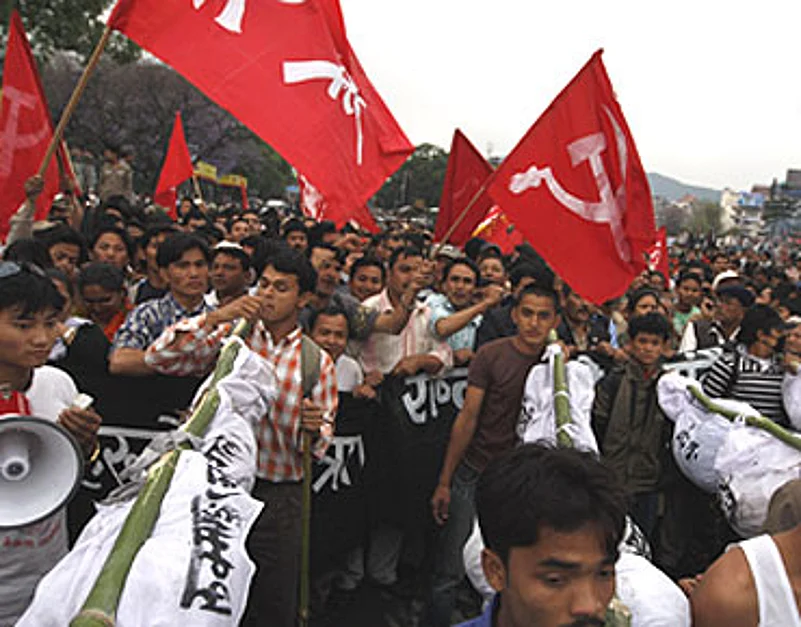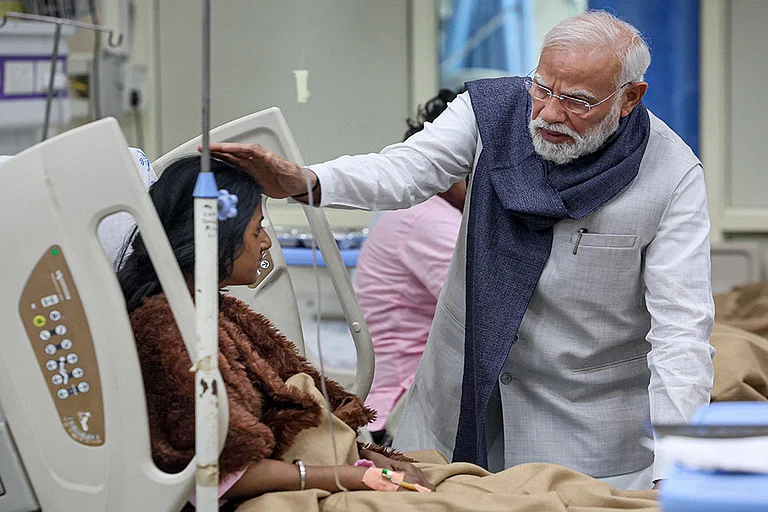- 1. Ensure Pakistan dismantles the terror appartus
- 2. Prevent future Nepali governments from playing the China card to isolate India
- 3. Nudge Colombo to urgently address the alienation of the Tamil people
- 4. Strengthen the pro-India government in Dhaka
- 5. Provide South Asian countries greater access to Indian markets
***
This has made many in the Indian foreign policy establishment feel "hemmed in" in a region New Delhi traditionally saw as its backyard. Former foreign minister Yashwant Sinha told Outlook, "Managing the neighbourhood should be on top of the list of the new government. The most important challenge is to re-establish India’s influence in the neighbourhood." Citing the presence of the US and other big powers in the region, Sinha says "India’s foreign policy can’t be outsourced. It’s we who have to evolve an effective policy".

Sri Lankan Tamils at a makeshift hospital in war-torn Mullivaaykaal
Considering the situation in South Asia, this is a tall task. Pakistan is on a downward spiral; its inability to take on the Taliban and Al Qaeda has turned large swathes of land along the Afghanistan-Pakistan border into ‘liberated zones’. Worse, the influence of jehadis has seeped into Islamabad and Lahore, much to the alarm of the foreign policy establishment here. An uneasy calm prevails in Bangladesh following the revolt of the Bangladesh Rifles, which brought to the fore the challenge the Hasina government faces from the Islamists. In Nepal, the Maoists have pulled out of the government, but retain the capacity to now paralyse a new ruling coalition. In Sri Lanka, the army is on the verge of vanquishing the LTTE, but doubts persist about peace returning to the island.
Worryingly, policy planners find it difficult to defend the idea of South Asia being India’s "exclusive zone" in a globalised world. Economic opportunities and terrorism have lured big powers to the region. America is flexing muscles in Afghanistan and Pakistan, compelling Islamabad to undertake military operations against militants. This suits India well. New Delhi has insisted that no solution in Afghanistan is possible without India. But many fear that once a new government takes guard in Delhi, Washington could mount pressure on India to kickstart the suspended dialogue with Islamabad. The corollary to the US’s attempt to play the neighbourhood policeman is the diminishing of India’s influence.
Beijing is also fast expanding its presence in South Asia, promising to assist the nations of South Asia in boosting economic growth. India can’t complain: with Sino-Indian trade reaching almost $40 billion, New Delhi can scarcely pressure other nations into not pursuing a similar trade policy. Beijing has increasingly become active in Kathmandu; the emergence of the Maoists as a stakeholder in Nepal potentially enhancing its importance.
This explains the growing opinion that India can no longer remain indifferent to the neighbourhood. "The need of the hour is to evolve a neighbourhood doctrine," says Sinha. He spells out the key elements of this doctrine—provide generous terms in trade and commerce to the smaller countries and allow them greater access to India’s market, and its technological and knowledge resources. In return, New Delhi should demand that the neighbours not compromise India’s security. "We must have well-defined red lines. They should be made to understand that under no circumstances should these lines be crossed," he added.
But officials argue that such "red lines" have to be flexible, not rigid. "They change according to the evolving situation," explains a senior Indian diplomat. "Moreover, we can’t be prescriptive. These are all sovereign nations to whom we can give suggestions when they seek it." Furthermore, as some in South Block argue, not all developments in the neighbourhood are inimical to India. "It’s a mixed bag," says a senior foreign ministry official. He cites Bhutan and Maldives to bolster his argument—these two have witnessed political changes for a more democratic and inclusive society, and their governments have taken serious steps to usher in economic progress.

Maoists protest in Kathmandu during the recent crisis. India is worried its influence can be eroded by Chinese presence in Nepal
There’s a sliver of hope even in countries facing serious challenges to their nationhood. For instance, the Hasina government, after crushing the BDR revolt, has taken steps to restore peace and ensure the schism in society doesn’t lead to a civil war. Even in Nepal the Maoists have been trying to resolve their differences with other political formations through negotiations, rather than take to the gun. The strife in Sri Lanka has neither arrested the economic growth nor crushed hopes of Colombo meeting the aspirations of the Tamil people.
If South Asia hasn’t spun out of India’s influence, it isn’t because of New Delhi. In fact, such was Prime Minister Manmohan Singh’s obsession with the nuclear deal that he visited only Afghanistan and Bhutan during his tenure. He did go to Sri Lanka and Bangladesh, but to attend the SAARC summit. He didn’t even visit Pakistan and Nepal, where India’s stakes are extremely high. "We need a very high and sustained political engagement in Nepal," K.V. Rajan, India’s former ambassador to Kathmandu, told Outlook. Referring to the Maoists’ charges that India has been meddling in Nepal, Rajan said, "But doing nothing cannot be an option. We’ll never get a good certificate from the Maoists. So, we might as well interfere to safeguard our interests."
In the past, India has actively intervened to salvage the situation in its neighbourhood. It did so in 1971 in East Pakistan that led to the creation of Bangladesh. It intervened in the Maldives in the mid-1980s to prevent a coup, and, a few years later in Sri Lanka, it sent in peacekeepers to deal with the ethnic conflict. As recently as 2005, it brought the Maoists and other democratic parties together in Nepal.
Yet these interventions have earned little gratitude among its neighbours. Some say this is typical of a small country paranoid of its bigger neighbour. Others find fault with India’s attitude. Having inherited the largest share of human, economic and natural resources of the subcontinent in 1947, successive Indian governments have regarded others in South Asia as camp followers. Says a senior diplomat of a South Asian nation. "New Delhi’s failures to treat many of these countries as sovereign nations having the right to take independent decisions according to their national interests has been one of the big factors for the trust deficit in the neighbourhood."
India’s neighbourhood policy abounds with ironies. While India has little influence over Pakistan, its policy is Islamabad-centric. This has prompted other nations to wonder if a belligerent anti-India policy is the best method of attracting its attention. "The India-Pakistan template is the worst one to follow," former diplomat Naresh Chandra confesses.
So, what then are India’s options? As Chandra told Outlook, "India’s biggest failure has been its inability to project itself as a ‘soft power’ in the region." He feels New Delhi should stress on engagement between the civil societies rather than limit its interaction to politicians and bureaucrats. He also points to the urgent need to establish a group comprising people from different walks of life in India to draw up a cogent neighbourhood policy. "It’s important that while developing such a policy they should not wear the Indian hat. Rather the emphasis should be on winning the trust and confidence of neighbours that we all share a common destiny of peace, progress and prosperity. And it can only happen if we stay together and work with each other and not against one another." In other words, it is time India stops playing the big brother and learns to appreciate the sensitivity of smaller nations in the region. Simultaneously, the smaller nations need to introspect. It takes two to tango.

























